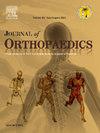Anticoagulation in patients with atrial fibrillation undergoing inpatient total knee arthroplasty: A matched analysis
IF 1.5
Q3 ORTHOPEDICS
引用次数: 0
Abstract
Background
Patients with atrial fibrillation (AF) often require lifetime anticoagulation using drugs such as Warfarin and Direct-acting Oral Anticoagulants (DOAC). It is important to assess the impact that prior anticoagulant use has on the post-operative complications in patients with AF undergoing TKA.
Methods
This is a retrospective analysis of the PearlDiver database querying all patients who underwent an inpatient TKA. Patients who had AF and filled a prescription for at least 30 days of either Warfarin or a DOAC were matched to control cohorts. Medical and surgical complications 30 and 90 days post-operatively were compared between the two groups.
Results
4396 patients made up the group with AF on warfarin, while 5383 patients made up the cohort with AF on DOAC and their corresponding controls. Patients on anticoagulation had more AKI (OR 2.70, OR: 2.37), pneumonia (OR: 2.89, OR: 2.46), MI (OR: 2.70, OR: 3.14), transfusion (OR: 6.94, OR: 3.16), sepsis (OR: 2.47, OR: 1.96), and aseptic loosening at 90 days (OR: 17.06, OR:7.01). However, PE (OR: 3.32) and hematoma (OR: 1.71) were only higher in the warfarin cohort. TKA instability was higher in the DOAC cohort (OR: 6.00). Conversely, patients in the control group exhibited more wound dehiscence compared to the warfarin group (OR: 0.28), and higher rates of revision surgery compared to both the DOAC (OR:0.27) and Warfarin (OR:0.31) groups at 90 days.
Conclusion
Patients on DOAC and Warfarin for AF, and undergoing TKA are exposed to a higher risk of post-operative complications.
接受住院全膝关节置换术的心房颤动患者的抗凝治疗:匹配分析
背景心房颤动(房颤)患者通常需要终生使用华法林和直接作用口服抗凝剂(DOAC)等药物进行抗凝治疗。评估之前使用抗凝药物对接受 TKA 手术的房颤患者术后并发症的影响非常重要。方法这是对 PearlDiver 数据库中所有接受住院 TKA 手术的患者进行的一项回顾性分析。心房颤动且开具华法林或 DOAC 处方至少 30 天的患者与对照组相匹配。结果服用华法林的房颤患者有 4396 人,服用 DOAC 的房颤患者及其对照组有 5383 人。接受抗凝治疗的患者在 90 天内发生 AKI(OR:2.70,OR:2.37)、肺炎(OR:2.89,OR:2.46)、心肌梗死(OR:2.70,OR:3.14)、输血(OR:6.94,OR:3.16)、败血症(OR:2.47,OR:1.96)和无菌性松动(OR:17.06,OR:7.01)的几率更高。然而,只有华法林队列中的 PE(OR:3.32)和血肿(OR:1.71)发生率较高。DOAC组的TKA不稳定性更高(OR:6.00)。相反,与华法林组相比,对照组患者的伤口裂开率更高(OR:0.28),与 DOAC 组(OR:0.27)和华法林组(OR:0.31)相比,对照组患者在 90 天后的翻修手术率更高。
本文章由计算机程序翻译,如有差异,请以英文原文为准。
求助全文
约1分钟内获得全文
求助全文
来源期刊

Journal of orthopaedics
ORTHOPEDICS-
CiteScore
3.50
自引率
6.70%
发文量
202
审稿时长
56 days
期刊介绍:
Journal of Orthopaedics aims to be a leading journal in orthopaedics and contribute towards the improvement of quality of orthopedic health care. The journal publishes original research work and review articles related to different aspects of orthopaedics including Arthroplasty, Arthroscopy, Sports Medicine, Trauma, Spine and Spinal deformities, Pediatric orthopaedics, limb reconstruction procedures, hand surgery, and orthopaedic oncology. It also publishes articles on continuing education, health-related information, case reports and letters to the editor. It is requested to note that the journal has an international readership and all submissions should be aimed at specifying something about the setting in which the work was conducted. Authors must also provide any specific reasons for the research and also provide an elaborate description of the results.
 求助内容:
求助内容: 应助结果提醒方式:
应助结果提醒方式:


